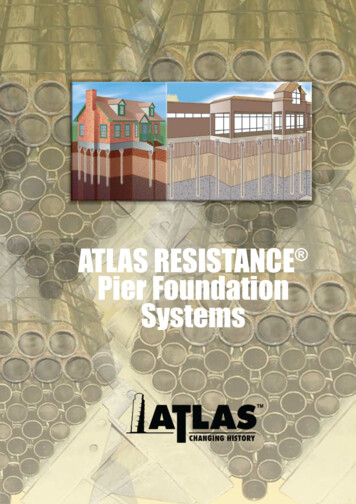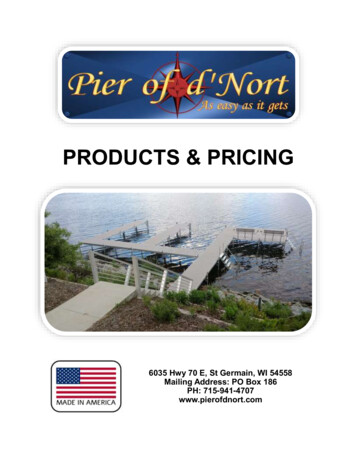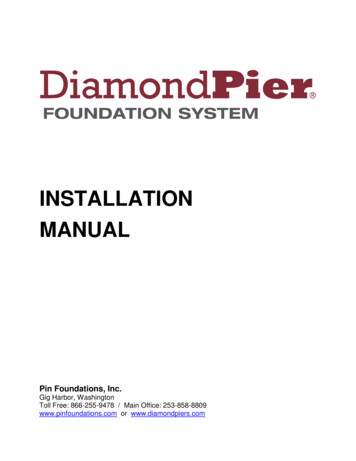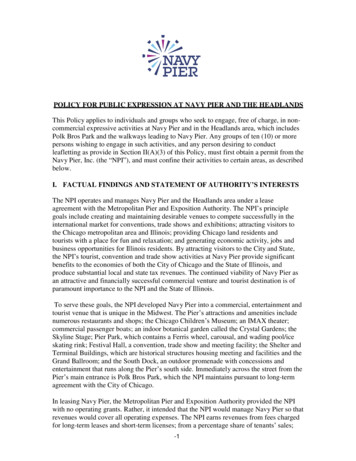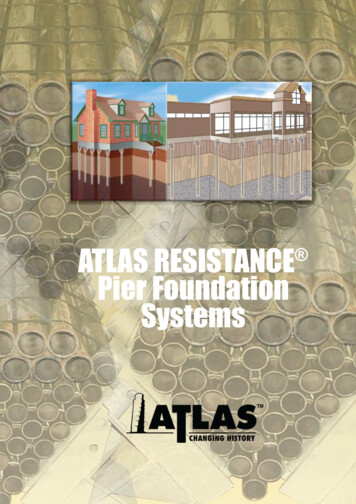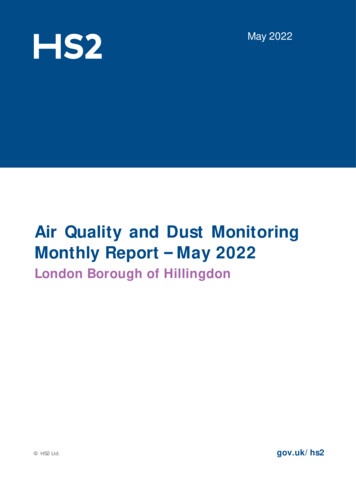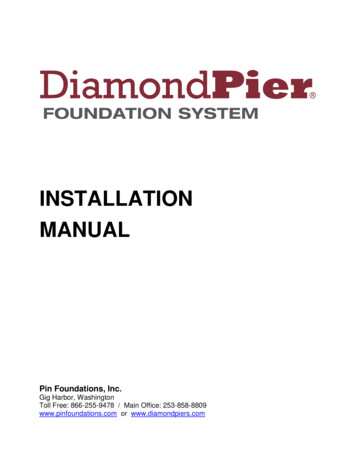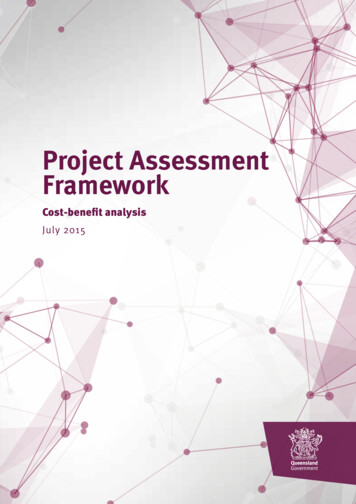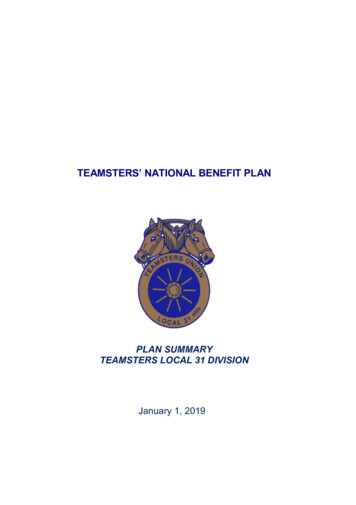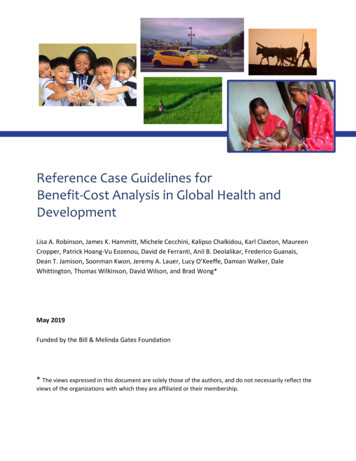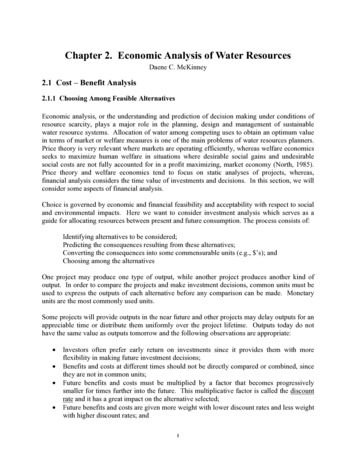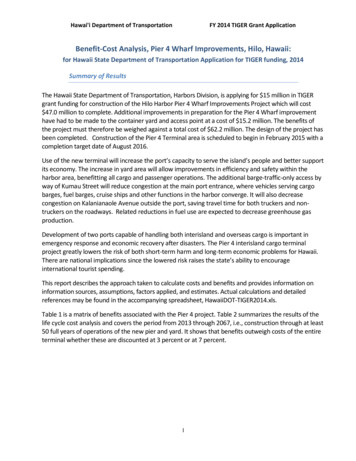
Transcription
Hawai'i Department of TransportationFY 2014 TIGER Grant ApplicationBenefit‐Cost Analysis, Pier 4 Wharf Improvements, Hilo, Hawaii:for Hawaii State Department of Transportation Application for TIGER funding, 2014Summary of ResultsThe Hawaii State Department of Transportation, Harbors Division, is applying for 15 million in TIGERgrant funding for construction of the Hilo Harbor Pier 4 Wharf Improvements Project which will cost 47.0 million to complete. Additional improvements in preparation for the Pier 4 Wharf improvementhave had to be made to the container yard and access point at a cost of 15.2 million. The benefits ofthe project must therefore be weighed against a total cost of 62.2 million. The design of the project hasbeen completed. Construction of the Pier 4 Terminal area is scheduled to begin in February 2015 with acompletion target date of August 2016.Use of the new terminal will increase the port’s capacity to serve the island’s people and better supportits economy. The increase in yard area will allow improvements in efficiency and safety within theharbor area, benefitting all cargo and passenger operations. The additional barge‐traffic‐only access byway of Kumau Street will reduce congestion at the main port entrance, where vehicles serving cargobarges, fuel barges, cruise ships and other functions in the harbor converge. It will also decreasecongestion on Kalanianaole Avenue outside the port, saving travel time for both truckers and non‐truckers on the roadways. Related reductions in fuel use are expected to decrease greenhouse gasproduction.Development of two ports capable of handling both interisland and overseas cargo is important inemergency response and economic recovery after disasters. The Pier 4 interisland cargo terminalproject greatly lowers the risk of both short‐term harm and long‐term economic problems for Hawaii.There are national implications since the lowered risk raises the state’s ability to encourageinternational tourist spending.This report describes the approach taken to calculate costs and benefits and provides information oninformation sources, assumptions, factors applied, and estimates. Actual calculations and detailedreferences may be found in the accompanying spreadsheet, HawaiiDOT‐TIGER2014.xls.Table 1 is a matrix of benefits associated with the Pier 4 project. Table 2 summarizes the results of thelife cycle cost analysis and covers the period from 2013 through 2067, i.e., construction through at least50 full years of operations of the new pier and yard. It shows that benefits outweigh costs of the entireterminal whether these are discounted at 3 percent or at 7 percent.1
Hawai'i Department of TransportationFY 2014 TIGER Grant ApplicationTABLE 1: MATRIX OF BENEFITS2
Hawai'i Department of TransportationFY 2014 TIGER Grant ApplicationTABLE 2: RESULTS OF THE LIFE CYCLE COST ANALYSISProjectThe Hawaii State Department of Transportation is submitting an application for funding through theNational Infrastructure Investments (TIGER) grant program. The application is for 15 million tocomplete work on the new Pier 4 in Hilo Harbor, County of Hawaii. Pier 4 is being built as part of athree‐part harbor improvement plan; (1) an expanded container yard area and (2) an additionalaccess point will be completed in advance of the new pier. Pier 4 will expand the Hilo harbor berthspace by 602 feet, an increase of 21.9 percent. The additional yard space serving Pier 4 covers tenacres. It expands the harbor’s working yard space by 48.1 percent. With the additional yard,different cargo loading and unloading operations can be separated, and handling of barge cargo canbe moved away from the route used by cruise passengers to cross between Pier 1 and Hilo town.For the life cycle cost analysis, dollar values are expressed as 2013 values. Escalation iscalculated in proportion to the Honolulu Consumer Price Index, except where federalguidance specifies other forms of escalation (e.g., sustainment costs; medical costs of injurieson the waterfront).Construction is scheduled to end in August 2016. Five months of operations are anticipated in 2016.The life cycle cost analysis runs for calendar years through 2067, i.e., at least 50 full years ofoperations, since all components of the terminal have a service life of 50 years or more.3
Hawai'i Department of TransportationFY 2014 TIGER Grant ApplicationBaselineWith or without the project, Hilo will see increasing cargo tonnages and passenger arrivals.Projections of increasing demand for goods, observed in terms of cargo tonnage, were developedfor the Hawaii Island Commercial Harbors 2035 Master Plan, where the compound annual growthrate [CAGR] was 2.5 percent.The future of cruise ship traffic is much less certain. One line dedicated three ships to Hawaiiduring the last decade but found the initiative unprofitable. Passenger counts have declined onlyto increase again with the end of the recession and more frequent visits by ships from other lines.In the analysis, the Hilo cruise passenger count is projected to be 2.6 percent.The State of Hawaii’s long‐term projections through 2040 call for growth in population (1.0%for Hawaii Island), visitor spending (3.4%, all visitors to Hawaii Island), and specifically cruisevisitor spending statewide (3.4%).In sum, continuing growth in demand for space in the harbors can be expected. Problems, risksand inefficiency due to congested harbor space and access to the harbors will increasingly addto the cost of doing business on Hawaii Island unless major repairs and improvements aremade. Table 3 presents key trends in the local economy.4
Hawai'i Department of TransportationFY 2014 TIGER Grant ApplicationTABLE 3: GROWTH PROJECTIONS, HAWAII ISLANDBASELINE2010PROJECTED203020202040Hawaii County185,406220,880258,510296,320Employment (Civilian Jobs)93,927112,230131,430151,690Personal Income (2010 , Millions) 5,040 6,700 8,450 10,120Average (Daily) Visitor Census24,74929,26032,70036,320 1,162 1,512 1,679 1,865 19 29 32 36PopulationVisitor Spending (2010 , Millions)Total Spending ( Hawaii County)Cruise Visitor Spending y in Hilo HarborTotal Cargo 369,427442,140571,523738,767SOURCES:Hawaii State Department of Business, Economic Development and Tourism, Populationand Economic Projections for the State of Hawaii to 2040. Posted cast/2040‐long‐range‐forecast/.Hawaii State Department of Transportation, Harbors Division (EP); wharfage statistics.5
Hawai'i Department of TransportationFY 2014 TIGER Grant ApplicationCostsCosts include construction costs for the pier, yard and access point1 as well as long‐termsustainment (including normal maintenance and repair). Construction costs and timeshave been calculated by Hawaii State DOT Harbors Division as totaling 62.2 million:1. Pier 4: 47.0 million, from February 2015 to August 2016 (18 months);2. Yard area: 11.6 million, from November 2013 to January 2015 (14 months)3. Access route: 3.6 million, from February 2014 to February 2015 (12 months)Sustainment provides for maintenance and repair activities necessary to keep a typicalinventory of facilities in good working order over their expected service life. It includes:1. regularly scheduled adjustments and inspections, including maintenance inspections(fire sprinkler heads, HVAC systems) and regulatory inspections (elevators, bridges)2. preventive maintenance tasks3. emergency response and service calls for minor repairs4. major repair or replacement of facility components expected to occurperiodically throughout facility service lifeSustainment costs can be estimated using standards developed from national data sets:Sustainment requirement Facility Quantity x Sustainment Unit Cost x Area CostFactor x Inflation Factor.The Unified Facilities Criteria2 database has annual sustainment unit cost rates as follow:1. FAC code 1511: pier: 31.76/SY2. FAC code: 1531: marine cargo yard: 1.31/SYThe Hawaii average cost factor for sustainment is 2.04. The escalation rate for sustainment to 2013 is1.018. This calculation is used in the life cycle cost (LCC) analysis, allowing for a 20% reductionin annual cost in the first five full years of operation. Maintenance and repair are expected tobe minimally needed during the first five years and to be required more in the years after.1Sustainment is not calculated for Kumau Street. This is a County of Hawaii roadway that will bestrengthened and widened by the State and returned to County management. Sustainment costs will beminimal.2Unified Facilities Criteria (UFC): DoD Facilities Pricing Guide\2\/2/, No. 3‐701‐01; Most recent update:August 2013 (Change 5).6
Hawai'i Department of TransportationFY 2014 TIGER Grant ApplicationBenefitsA. Quantifiable BenefitsQuantifiable benefits to the Hilo Harbor area include:1. Increased efficiency in cargo handling at the pier and yard, measured through yard man‐hours, customer time, fuel use, and equipment replacement;2. Increased safety through the lowering of injury risk;3. Lower travel costs and improved roadways as outcomes of reduction in trafficcongestion;4. Improved capability to facilitate emergency response and recovery efforts bothimmediately after a crisis and for longer‐term recovery; and5. Reducing the social cost of carbon by reducing fuel use.Improved Efficiency at Hilo Harbor and in the Yard for Interisland Barge CargoInter‐island cargo loading and unloading at the well‐used and weakened Pier 2 will be moved tothe new Pier 4 at Hilo Harbor. Movement of these operations to Pier 4 will reduce co‐minglingof passengers arriving at Pier 1 with cargo movements as well as restore productivity to shipperoperations.With the new pier built to code with larger, convenient yard space, the barge cargo operatorwill be able to operate much more efficiently. Improvements are anticipated in:1. Cargo Handler Operations: Load and unload operations using two ramps per barge wouldshorten the operation time. Handlers would also experience lower wait times as well asfewer incidents of having to move loads to clear paths for others. Based on estimates byprivate sector and Harbors professionals, the impact would be a savings of 15 percent ofoperators’ time.2. Container Yard Customer Service: With a larger yard, customer service systems can bereorganized to speed cargo handling. The larger area would also allow staff to strategicallyplace cargo for better access by customers. The estimated impact is ten percent ofcustomer service staff time.3. Fuel Usage: With fewer and shorter cargo movements, fuel usage would decline as well by 15percent.4. Equipment Life: Shorter movements by large equipment would reduce wear and tear,allowing the equipment to be maintained well and used over a longer period. The increase inservice life is estimated at 10 percent.33The value of heavy equipment is treated statically here, based on input from the cargo operator. Theincrease in service life was estimated by operator management after consultation with Hilo staff.7
Hawai'i Department of TransportationFY 2014 TIGER Grant ApplicationThe benefits of the new pier and yard are expected to increase over time as cargo volumesgrow. In 2011 dollar values, savings in man‐hours ( 116,042), customer service man‐hours( 42,978), fuel usage ( 9,352), and extended equipment service life ( 16,000) total to 184,372.4Efficiency of Work in Hilo Harbor yards, other than Interisland Cargo BargesOnce interisland cargo barge traffic and yard activities are moved to Pier 4, movement of allequipment and other vehicles in the yards will be more efficient, with reduced wait times andstorage or staging of materials and vehicles at convenient sites, not just wherever there is space.The benefit is estimated to be a 10 percent reduction in man‐hours for workers in the harbor yards.With more efficient movement and less time spent waiting for others to clear the way betweenthe piers and yard areas, fuel usage would similarly decline.Customers’ Time in the Hilo Harbor YardsHilo Harbor serves cargo barges, cargo ships (including RoRo and RoRo/container mixedoperations), fuel barges, and cruise ships. The mix of customers passing through the main entrance5varies depending on the vessel types present in the harbor. Interisland cargo barges visit HiloHarbor an average of 121 days annually6. Cruise ships visit seasonally over a period of about ninemonths (i.e., 100 days). Ordinarily, truckers visiting the interisland yard must pass through twosecurity stops. When cruise ships are present, however, they must pass through three securitychecks. In either case, there are delays depending on the number of others ahead waiting to passthrough.Although many interisland barge yard customers come on barge days, they also come on otherdays to drop off or pick up loads. The analysis is based on the number of vehicles to sites in theharbor (interisland cargo yard, cruise ship, office, fuel pier and other) at four levels of traffic (novessel; barge only; cruise ship only; both barge and cruise ship present). Reductions in travel timewithin the harbor are due to fewer security checks, shorter lines to pass through those checks,and increased capacity to move, park and load within the yards.After the new Pier 4 opens, parts of Pier 2 can be used to stage buses and othercruise‐related traffic, reducing delays.Risk of Unintentional Injuries or Fatalities in the Harbor AreaIn a crowded harbor area, events causing unintentional injuries or fatalities can occur, affecting maritimeworkers and others in the harbor. At Hilo, the risk of these kinds of events is, in the baseline case, raised by4See BCA file for Hawai'i, worksheet "1‐individual calculations."In recent years, a second entrance serving the cargo yard used by Matson south of Pier 1 was opened.This has lessened traffic through the main gate and quickened the flow. This improved efficiency hasbeen, in part, reported anecdotally.6Hawai'i Dept of Transportation ‐ Harbors (EP), wharfage statistics.58
Hawai'i Department of TransportationFY 2014 TIGER Grant Applicationthe use of a single entry for access to barges, ships, and the Harbor office; by limited yard space whereequipment operators must wait for traffic or negotiate with each other to move cargo; and by the mix ofworkers, customers coming to pick up cargo, cruise passengers, buses and other vehicles.The risk of injury to harbor workers can be estimated from government data; there is insufficient data,however, to calculate the risks to others (e.g., passengers, visitors, truckers).The U.S. Department of Labor tracks the cost of injuries and fatalities to maritime workers. Data on that costfor the Hawaii harbor system is available for 2006‐2008.7 At that time, the total average annual cost for theHawaii system as a whole was 6.6 million. The share of the average cost attributable to activities at Hilo canbe estimated as a share of the system cost. That share is calculated here in terms of the share of cargo, otherthan petroleum, handled in each port.8 Hilo’s share in 2011 was 7.2 percent.The 2006‐2008 risk of injuries or fatalities at Hilo were assigned an estimated cost of 473,958. Thiscan be updated to 2013 values, given the high rate of increase in medical costs, as 735,258, based onincreases in the statistical value of a life.The terminal lowers the risk of accidents by separating barge traffic from cruise and other traffic and byincreasing yard space. With yard space increasing by 45 percent, it is reasonable to expect that thelikelihood of events leading to injuries or fatalities would decline at half that rate (23 percent). Theaverted risk can be valued at 167,104 annually.Traffic Congestion on Kalanianaole Avenue and Nearby RoadwaysReduced congestion, and hence wait time for truckers and others traveling to and from Hilo harbor(truckers’ and drivers’ time, fuel usage).Kalanianaole Avenue stretches from the Hilo urban center approximately five miles to the south, past theharbor and the community of Keaukaha to popular beach parks. The road is often congested by traffic to andfrom the harbor, especially when cruise ships are in port with a variety of buses, taxis, trucks and carsconverging on the harbor. As with the benefit from reducing the risk of unintentional injury, the analysis oftraffic congestion considers congestion on different days.The added point of access9 will reduce queuing of vehicles on the roadway north of the harbor and eliminatelong waits for traffic turning onto or from the main roadway. The expected impact would average a waittime of a minute for vehicles on most days and a little more on days when a cruise ship is in port. Given allthe traffic on the roadway, the improved traffic flow would reduce travelers’ time by more than 40,000hours per year, at a time savings (for truckers and others) of an estimated 638,798 as of 2013. With savings7U.S. Department of Labor, Division of Longshore and Harbor Workers’ Compensation, San FranciscoOffice, 2011.8Nearly all petroleum products used in Hawaii enter the state via an offshore mooring near BarbersPoint Kalaeloa Harbor, O'ahu. These are excluded in order to focus on human activities in the ports.(without a barge or ship, with a barge, with a cruise ship, with both), but considers both harbor trafficand other traffic nearby.9Results of a traffic study are presented in the Environmental Assessment for the Kumau Street access:R.M. Towill Corporation, Draft Environmental Assessment, Kumau Street Entrance Improvements at Pier4, Interisland Cargo Terminal Project. Prepared for the Hawaii State Department of Transportation,Harbors Division. Honolulu, HI, 2012. The study provides information on peak traffic hours and volumes.9
Hawai'i Department of TransportationFY 2014 TIGER Grant Applicationin drivers’ time also comes fuel savings. As of 2013, fuel savings are estimated at 138,152 annually,increasing over time.Greenhouse Gases – Measure of the Social Cost of CarbonBoth within and outside of Hilo harbor, lower fuel usage would reduce Greenhouse Gas (GHG)production, a measure of the social cost of carbon.Future fuel costs may be estimated based on the average costs of diesel ( 4.75 per gallon) and regulargasoline ( 4.08 per gallon) in Hilo, as of March 2014.Various reductions in fuel use contribute to reductions in the production of carbon. Based on emissions ratesfor idling vehicles, there would be a savings of 18,829 gallons of diesel and 42,633 gallons of gasoline due toimproved traffic in or near the harbor. The amount of carbon averted through this reduction would exceed600 short tons by 2016, providing an annual benefit in dollars of 17,055 in 2016 and rising to 98,647 by206510.Emergency Response and Recovery after Major EmergenciesHawaii Island has had continuous volcanic eruptions since 1983 and is always, like the other islands, at risk ofnatural disasters (i.e., tsunami, hurricanes, earthquakes). Kawaihae was severely damaged in 2006 duringthe Kiholo Bay/Mahukona earthquake. No port activity occurred at the harbor there for three daysafterward; two of the three piers were unusable for more than a year. The Mauna Kea Beach Hotel nearbyclosed for repairs for over a year. In 2011, a tsunami inundated much of the Kona Village Resort.Hilo has not been exempt from disaster. The 1946 Hilo tsunami swept over the port and parts of the townnear the ocean, killing 159 people. (The piers currently in use at Hilo Harbor were re‐built in 1946 after thewave destruction.) Lava flows from Kilauea have reached the outskirts of Hilo; the community of Kalapanawas completely encased and destroyed by lava in 1990. The geological record further indicates thatextensive landslides can be triggered by eruptions, leading to massive tsunami. There is the risk of such aslide off lower Puna, affecting coastal areas around the island.Hawaii Island is served by two commercial ports, Kawaihae Harbor and Hilo Harbor. Kawaihae, located inWest Hawai‘i, receives cargo vessels but none of the cruise ships. Hilo Harbor receives cargo, all the cruiseships visiting the island, and much of the fuel cargo for distribution island‐wide. Each harbor serves a slightlydifferent shipping purpose. However, in the event of an emergency, having both ports in states of goodrepair will better facilitate emergency response for the island and decrease the risks to health and safety.The benefits of quick and reliable access to emergency supplies and equipment as well as the capacity toimport materials needed for repair and recovery after a disaster are estimated herein. Potential earthquakescenarios, based on Hawaii Island geography and history, are listed in Table 4. The estimates and modeledscenarios are based on both actual and hypothetical events and are made available as reference points todisaster managers, in case of an actual earthquake, until new HAZUS model results come in.1110Calculations apply cost factors provided in the TIGER Benefit‐Cost Analysis (BCA) Resource Guide.Pacific Disaster Center, Hawaii HAZUS Atlas, "Earthquake Planning Scenarios for Hawaii DisasterManagers."1110
Hawai'i Department of TransportationFY 2014 TIGER Grant ApplicationTABLE 4: HAZUS EARTHQUAKE SCENARIOS, HAWAII ISLANDEpicenter LocationDepthMagnitude(See Map)(Km)(Moment)HHA Kau M6 ScenarioHHA Kaoiki M6 ScenarioHHA Kaoiki M7 ScenarioHHA Kilauea South Flank M7ScenarioHHA South Kona M6 ScenarioHHA Kau M7 ScenarioHHA South Kona M7 ScenarioHHA South Kona M8 ScenarioHHA North Kona M6 ScenarioHHA North Kohala M7ScenarioHHA Honomu M6 ScenarioHHA Kau M8 ScenarioHHA Kiholo Bay M6.7 EventHHA Kalapana M7.7 ScenarioHHA Honomu M7 ScenarioEvent DateDamage( Million)101010106 Sunday, June 30, 20136 Sunday, June 30, 20137 Sunday, June 30, 20137 Sunday, June 30, 20131210229361101010103030677867Sunday, June 30, 2013Sunday, June 30, 2013Sunday, June 30, 2013Sunday, June 30, 2013Sunday, June 30, 2013Sunday, June 30, 2013881465565586620842103910426 Sunday, June 30, 20138 Sunday, June 30, 20136 Sunday, Oct 15, 20067 Sunday, June 30, 20137 Sunday, June 30, 201391569498347560Figure 1 ‐ Scenario Epicenters on Hawai'i IslandSOURCE: Hawaii HAZUS Atlas, HAZUS Scenario Summaries.11
Hawai'i Department of TransportationFY 2014 TIGER Grant ApplicationBased on the historical record and the HAZUS analyses, the likelihood of an event capable of crippling oneor the other of the two ports on Hawaii Island is once in 50 years. The likelihood of a disaster capable ofextensively damaging Kawaihae, leaving the island dependent on Hilo, would be once in 100 years.Materials and equipment needed for emergency response are found on each island, but not inquantities sufficient to address either immediate or long‐term needs. After a disaster, airplanes andbarges would bring to the island emergency responders and their equipment, relief supplies, and heavyequipment to clear damaged areas and limit further deterioration. Early deployment of post‐disasterresponse could limit damage and speed recovery. If an earthquake similar to the 2006 event were totake place today with the condition of Pier 2 as deteriorated as it is, the pace of recovery would be muchslower than in 2006. Table 5 provides an estimate of the value of supplies needed for emergencyresponse and recovery where their delivery would depend on the survival of a fully functioning harboron the island. That value is expected to have a 1 in 50 likelihood of occurrence. The likelihood that Hilowould serve as the sole functioning harbor, with Kawaihae damaged, is then a 1 in 100 chance. Benefitsfrom effective preparation for and emergency response to such an event are treated as accruing withconstruction of the Pier 4 terminal.TABLE 5: BENEFITS ASSOCIATED WITH A FUNCTIONING HARBOR IN THE EVENT OF MAJOR DISASTER,HAWAII ISLANDDamage, 2006 earthquakeValue of immediate response1. medical supplies, assistance2. other relief supplies3. food (recovery)4. cement5. other building materialsShare of totaldamages1%1%1%10%10% 366million 3.7 3.7 3.7 36.6 36.6SecondHarborShare(%)30%50%30%95%95%Second HarborShare in (Millions) 1.1 1.8 1.1 34.8 34.8 73.6Likelihood of eventAnnual value of avoiding anyloss of capacity, eitherharbor1 in 50 1.5millionAnnual value, full capacity atHilo if Kawaihae damaged1 in 100 0.7millionSOURCES: Interviews with emergency managers, Harbors personnel, shippers; presentation by JamesBell on recovery and planning for Hilo after the 1946 tsunami. Estimated shares developed by BeltCollins Hawaii LLC.12
Hawai'i Department of TransportationFY 2014 TIGER Grant ApplicationThe economic impact of repairs and recovery is significant. Hawaii Island and Kauai, located at oppositeends of the island chain, are at higher risk of being affected by natural disasters and report lower visitoroccupancy rates than Oahu and Maui. After a disaster, the visitor industry works quickly to let the globalpublic know that Hawaii is still "open for business." Recovery, however, is a slow process where repairs andrenovations may take as long as a year or more. While recovery may mean an increase in constructionemployment locally, the infrastructure supporting the visitor industry must be restored before tourismlevels and service industry employment return to normal. Port capacity is crucial to economic recovery atboth state and island levels.The benefit of earlier recovery for a tourism‐based economy lies in an earlier return of visitors to minimizethe share of visitors lost. A rapid recovery saves at least six months of visitor expenditures over a period oftwo or more years. Although some of the revenues lost due to a slower recovery could be regained later,dollars could be lost through tourist diversion to other locations. US visitor dollars could be diverted fromHawaii to Caribbean and Mexican resorts while international visitors could opt to visit Southeast Asiaresorts or other Asian destinations instead. Since the share of domestic visitor spending that would bediverted from Hawaii to other United States destinations is unknown, this analysis deals only withinternational spending.1. International visitor spending, Hawaii Island, 2011: 287.5 million (19% of total visitor spending)2. Assumption (a) Rapid recovery would result in retaining six months of visitor expenditures3. Assumption (b) Otherwise, 50 percent of those visitor expenditures would be lost tonon‐US destinations4. Impact of rapid recovery is then estimated as 287.3 x .5 x .5 71.9 million (as of 2011)5. The impact increases from year to year due to increases in visitor spending6. The benefit is associated with (1) a 1 in 50 year likelihood (i.e., 2%) of a major disasterextensively damaging one of the ports, or (2) a 1 in 100 year likelihood (i.e., 1%) of a disasterleaving Hawaii Island dependent on shipments through Hilo alone. The annual benefit wouldamount to 0.7 million annually as of 2013, increasing over the study period.B. Short‐term BenefitsShort‐term benefits can be calculated but are considered local impacts and are not included in the lifecycle cost analysis. The immediate impact is an increase in emergency management and constructionspending. Another possible impact is the positioning of the region for economic recovery throughrenovation of the infrastructure following a disaster. However, the likely overall impact is a reduction ineconomic activity.The number of workers in direct construction would vary with construction cost. Heavy constructiongenerates major expenditures for materials and equipment, where the share of the worker‐relatedcost is lower. The number of person‐years of work is calculated from the State of Hawaii average (for2011): Construction job count / construction tax base *1,000,000 4.85 construction workers permillion of construction spending; Adjusted to 75% of ratio (for heavy construction) 3.64 worker/ million .The number of indirect and induced jobs can be calculated through either the Input‐Output Model or thedirect investment ratio included in the TIGER BCA Resource Guide. The Input‐Output Model is based on13
Hawai'i Department of TransportationFY 2014 TIGER Grant Applicationresearch by the federal Bureau of Economic Analysis and refined by the Hawaii State Department ofBusiness, Economic Development and Tourism. It yields a Type II jobs multiplier of 2.68 (i.e., 1.68 indirectand induced jobs per direct job). At the national level, the TIGER BCA Resource Guide indicates that a job iscreated for every 76,900 of direct investment.TABLE 6: SHORT‐TERM BENEFITS – JOB CREATIONNOTE: Numbers in columns may not sum due to rounding.SOURCES: DBEDT, 2007 Input‐Output Benchmark Report; US Department of Transportation, TIGER BCAResource Guide.C. Non‐Monetized BenefitsMeasures for some of the benefits recognized could not be quantified due to small sample size or lack ofdata, e.g., impact of traffic congestion at Hilo Harbor on cruise passengers. Another unquantifiable benefit isthe increased capacity of Hawaii Island to manage major projects that require holding and staging areas nearthe ports. This capability will facilitate the construction of the Thirty Meter Telescope at the summit ofMauna Kea, planned to begin in the summer of 2014.With respect to emergency response, it is not possible to estimate the number of lives saved due to earlyarrival of relief supplies. When hospitals on Hawaii Island were damaged in the 6.6 magnitude earthquakethat occurred in 2006, many severely injured victims were airlifted to hospitals. The rapid arrival ofemergency responders and supplies likely prevented deaths although it is not possible to provide ameasurement of this.14
Hawai'i Department of TransportationFY 2014 TIGER Grant ApplicationReferencesAAA; Daily Fuel Gauge Report (Hawaii); retrieved fromhttp://fuelgaugereport.aaa.com/?redirectto http:/
grant funding for construction of the Hilo Harbor Pier 4 Wharf Improvements Project which will cost 47.0 million to complete. Additional improvements in preparation for the Pier 4 Wharf improvement have had to be made to the container yard and access point at a cost of 15.2 million.
